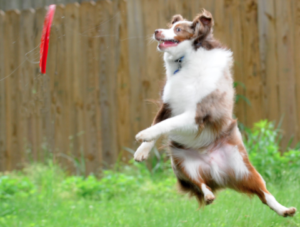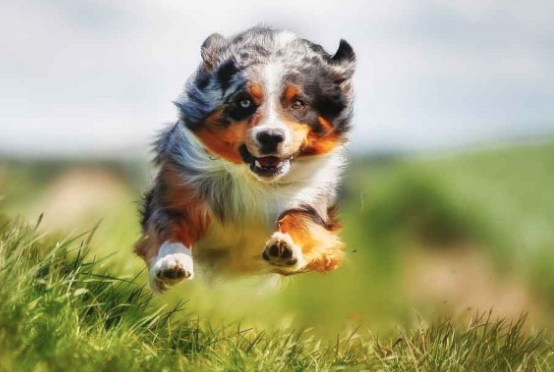By Jaclyn Amaru
As people are developing healthier, more active lifestyles, our furry friends are reaping the benefits as well. From partaking in daily hikes, jogs and fetches to even some extreme sports like swimming, skateboarding or agility courses, active dogs are on the rise! As humans, we are aware of proper etiquette when it comes to caring for our bodies’ pre and post workout, but many forget that we should be taking the same precautions for our pets as well, to ensure their longevity. Here are some useful tips to maintain a healthy dog:
Adequate Nutrition and Hydration
Be sure that your canine is eating enough at the proper times to account for the energy he is utilizing by scheduling food at least 6 hours prior to strenuous activity. Make sure your dog’s food contains appropriate caloric counts, vitamins, minerals, etc. for your dog’s age and breed. Consult your veterinarian with nutritional concerns.
With respect to hydration, proper cool down is difficult if hydration status is just a few percent too low. Depending on the activity and outside temperature, hydration can begin anywhere from the night before to 2-3 hours prior to start time. Encouraging water intake can be difficult, try putting bone broth in their water to make it more enticing to drink and don’t forget to walk your dog to relieve all that water!

Proper Warm-Up and Cool-Down
You wouldn’t start a run before stretching or doing a light jog and you wouldn’t finish cycling 50 miles by simply dismounting and calling it a day? So why don’t we incorporate this thinking with our dogs as well? Dog’s benefit from proper warm-up and cool-downs just like us, they help to prevent injury and promote better performance. Warming up gets the blood circulating, sharpens the mind and allows our dogs to eliminate any excess urine or stool. Likewise, cool-down’s should include a walk that allows the dog’s temperature and heart rate to return to baseline. Hydration is also vital in the cool-down phase for a healthy dog.
Adequate Recovery Phase
Recovery refers to a period of rest and repair. Recommended time can vary depending on the degree of activity, but for any healthy dog, should consist of a diet high in protein to mend muscular micro-tears and stretches to ameliorate sore spots. Homeopathic remedies like acupuncture, physical therapy and massage should also be considered. Canine massage is a widely underutilized treatment to care for aching muscles after tough workouts, as well as a way to ease physiological and psychological stress related to performance. While there is a National Board of Certification for Animal Acupuncture and Massage to certify and license professional masseuses, canine massage can also be initiated at home to help ease inflammation, joint pains or minor aches.
To assist with massage, both in home or by a professional, Dr. Pat Bona developed a tool known as Posture Prep, an ergonomic handheld massage groomer, which relaxes muscles and improves circulation, lymphatic drainage and range of motion in joints, including vertebrae, using the cross-fiber massage technique. Developed originally for horses, Dr. Bona designed a version specifically for dogs and small animals with slightly softer teeth. The groomer contours around the dog’s body and slides with the skin, penetrating the deeper muscle layers and tissue to help release buildup of toxins, like lactic acid after a tough workout, making this more than just your ordinary groomer. Posture Prep can be used pre-workout as well, to assist with priming the muscles and stimulating circulation, and thus oxygen supply to tissues. Furthermore, if your dog suffers from a particular ailment covered by your dog health insurance, certain homeopathic treatments, like dog massage, may be covered under your plan.

Canine massage is good for any active, healthy dog, but is particularly helpful in the subset of aging, active dogs to help battle arthritis. Arthritis, by definition, is painful, swollen, inflamed joints. Exercise is great for dog arthritis, as it strengthens the muscles across joint spaces, helping to relieve tension; but it is important to undertake local care to those muscles, after exercise, when injury is most likely to occur. By stimulating deeper tissues surrounding inflammation, you encourage circulation, which in turn carries blood rich products needed for healing to the area. Posture Prep can help with that, all while creating a deeper relationship with your best bud. The good news is Posture Prep also comes in a version for humans.

Maintaining Healthy Weight
It is somewhat unrealistic and inhumane to ask your dog to perform a demanding task when not at an ideal weight. The risk for injury is extremely high here due to the strain placed on the body and a canine’s inherent temperament to please; a dog may work well beyond its body’s limit. As a gauge for a healthy dog weight, an athletic dogs’ ribs should be felt, but not seen. If you are not sure how to get your dog to an ideal weight or where your dog’s ideal weight should be, consult with your veterinarian.
Yearly Wellness Exams
Sometimes we take our health for granted and we sometimes do the same for our pets. Often, we could avoid big medical bills by catching a small problem early with regular, preventative, well visits. Don’t let the fact that your dog exercises regularly and eats well fool you into thinking he is a healthy dog. Have your dog checked at least yearly by your vet for any signs of illness or disease. Things that often go overlooked are the ears, teeth and eyes.
At the end of the day, for all the unconditional love they provide us and unrelenting enthusiasm for whatever task we ask them to perform, it’s only right that we do our part to give back and watch out for their well being.

